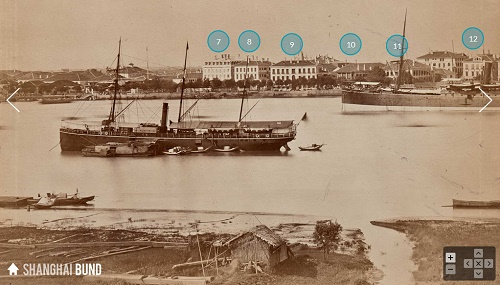
To celebrate the upcoming opening of Shanghai Tower, the world’s second-tallest building, the Peabody Essex Museum (PEM) has made available online a photographic panorama of the Shanghai Bund from 1882. The image, a rare treasure from the museum’s significant collection of 19th-century photographs of China, allows viewers to place the sleek skyscraper in context with the historic waterfront.
This 11-foot panorama of the Shanghai Bund (wai-tan in Chinese) — found online at pem.org/sites/shanghai_bund — consists of 13 albumen prints joined to form a sweeping view of the Shanghai waterfront. Although similar panoramas are known, PEM’s appears to be the largest in existence and the only one to contain so many detailed annotations. Eighty-one handwritten notes, describing the waterfront, identify different locations on the waterfront and describe their commercial, maritime, diplomatic or recreational activities. Likely annotated by its original owner shortly after the panorama was made, these notes and the corresponding images provide new insights into the bustling and fast-changing international port city at a critical moment in China’s modern history. The panorama was created by the Shanghai-based Kung Tai studio, which specialized in producing multipart panoramas of the Bund. Made every few years to document the rapidly changing city, these panoramas were frequently bound into souvenir albums and marketed to foreigners.
Shanghai’s cosmopolitan glamour can be traced to the 1840s with the influx of international settlers to the new treaty port. The Bund, the waterfront area strategically located along the Huangpu River, soon became a hub of trade and an icon of modernity. In the 1870s and ‘80s, new buildings were erected on the Bund at an unprecedented speed. A leading American business, Russell and Company, had just erected its grand building the year before the panorama was made (see No. 17). While international firms thrived in Shanghai, in the early 1880s, local business, such as the China Merchants’ Steam Navigation Company, gained a strong foothold at the Bund (see Nos. 2-4). The Kung Tai studio was located nearby. To capture this panorama, the photographer stood in the area now called Pudong across the Huangpu river. Visible in the foreground of the panorama, this area was just starting to be developed when the photographs were made and is now covered with tall skyscrapers. The Shanghai Tower, the world’s second-tallest building at 2,073 feet, will open this fall, an extraordinary addition to Shanghai’s vertical, futuristic skyline. (The Shanghai Tower would be between Nos. 3 and 4.)
An interactive microsite, created by PEM’s Integrated Media Department, is now available for users to study the panorama in detail. PEM researchers have deciphered and translated the accompanying handwritten notes. Each note is matched to its reference site along the panorama.
“We are proud to share this important legacy in our museum’s collection through new research and digital technology with our friends in China and the rest of the world so that we can all compare the historic Shanghai Bund with the dramatically altered skyline that now surrounds the Shanghai Tower,” said Daisy Wang, PEM’s Curator of Chinese and East Asian Art. “As a leading 18th- and 19th-century American port city here in Salem, Massachusetts, we recognize the impact global trade made on the city of Shanghai and its cultural ties with America.”
Salem and Shanghai have a number of historic and enduring connections. Salem resident Frederick Townsend Ward (1831-1862) sailed to Shanghai at the age of 15. As commander of the Ever Victorious Army, he trained 10,000 Chinese soldiers to fight against rebels in China. After he died on the battlefield, the Chinese government sent his family substantial funds, which were eventually donated to PEM to establish one of the finest collections of Chinese books and photographs in the U.S.
Today, PEM houses the largest and most significant American museum collection of 19th-century photographs of China. Remarkable for its breadth and depth, this collection of more than 10,000 photographic prints includes works by nearly all major photographers and studios operating in Shanghai, Beijing, Guangzhou, Fuzhou and many other cities in China. “This ambitious multi-part panorama reveals the extraordinary synergy between industrialization, photography and trade in Shanghai at a moment of great transformation,” said PEM Curator of Photography Sarah Kennel. “And just as photography was deployed in the 19th century to document change and celebrate modernity, it continues to be used today by contemporary artists to explore the ever-evolving face of modern China. PEM’s collection of 19th and early 20th-century photographs of Shanghai allows us to chart the spread of photography across the region and provides fascinating insight into both continuity and change over the past 150 years.”
Other important items related to Shanghai in PEM’s collection include the earliest known commercial photographs of Shanghai, late 1850s views of the Yuyuan Garden by the French photographer Louis Legrand (b. about 1820), who established a studio in Shanghai in 1857. The museum’s 19th-century photographs of Shanghai are complemented by the recent acquisition of some 1,000 photographs made by Harold Bucklin (1886-1967), an American sociologist who lived in Shanghai in the 1920s.
“Our unparalleled collection of photographs of China, particularly of Shanghai, tells important stories of the past,” said Wang. “It also allows us, as the first American museum to collect and appreciate Chinese art, to renew our ties with China at this extremely exciting moment in Chinese history and U.S.-China relations. We used sea routes then and now we use the Internet.”
FOR MORE INFORMATION
To learn more, see PEM’s blog Connected to read an interview with curators Daisy Wang and Sarah Kennell: http://connected.pem.org/exploring-a-historic-panorama/


